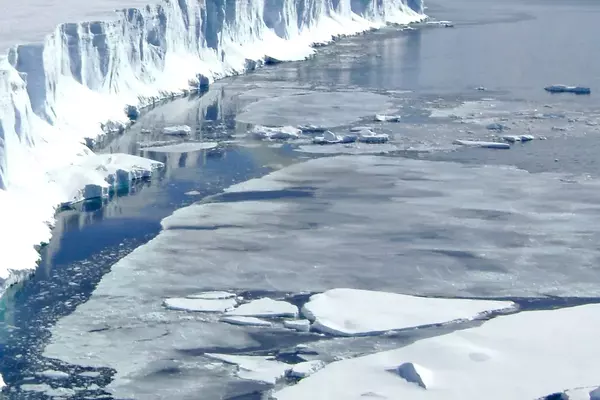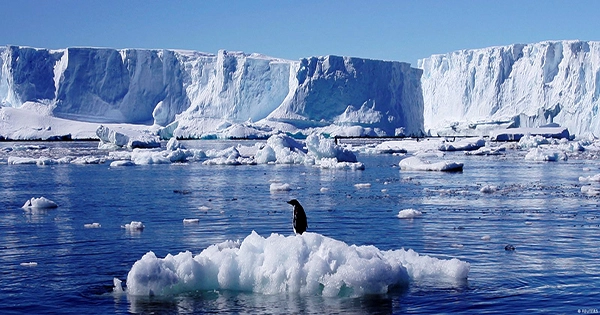Researchers have identified a technique that may aid in the Antarctic ice shelves’ melting.
A multinational team of scientists discovered that the instability of one ice shelf might affect others downstream.
The study, which was conducted by the University of East Anglia in the UK, also found that the Thwaites Ice Shelf’s proximity to a small ocean gyre, a network of cycling ocean currents, can affect how much meltwater flows beneath it. More warm water can enter the areas below the ice shelf when the gyre is weaker, which causes the ice shelf to melt.
One of the largest ice shelves in West Antarctica, the Thwaites Ice Shelf supports the glacier’s eastern side. The Thwaites Glacier, the largest contributor to sea level rise among Antarctic glaciers, has been retreating quickly over the past 20 years.

The researchers found that the shallow levels of the ocean beneath the Thwaites Ice Shelf warmed significantly between January 2020 and March 2021 using a unique dataset gathered by sensors placed beneath the ice shelf, which has been significantly thinned and weakened in recent decades.
The majority of this warming was caused by waters containing a significant amount of glacial meltwater pouring into the region below the Thwaites Ice Shelf from the Pine Island Ice Shelf, further east.
When the ocean melts the base of ice shelves, glacial meltwater mixes with saltwater to create a buoyant layer of water that is warmer than the surrounding waters. The Thwaites Ice Shelf’s base dissolves due to the heat from this fresher, lighter, and lighter water.
“We have uncovered another process that could effect the stability of ice shelves, highlighting the importance of local ocean circulation and sea-ice,” said Dr. Tiago Dotto, the paper’s lead author and director of the Centre for Ocean and Atmospheric Sciences at the University of East Anglia.
“An important factor in the melting of the bases of ice shelves is circumpolar deep water, a warm variant of Antarctic waters. However, in this study, we demonstrate that waters from surrounding melting ice shelves can provide a significant amount of heat to shallow levels beneath one ice shelf.”
“Because of this, what happens to one ice shelf may have an effect on the one next to it, and so on. Because one ice shelf is near to the next and heat can be exported from one ice shelf to the next through ocean circulation, this process is significant for areas where ice shelves are melting rapidly, such as the Amundsen Sea.”
These interactions between the atmosphere, sea ice, and ocean, continued Dr. Dotto, “are significant because they can extend warm periods beneath ice shelves by allowing warm and meltwater-enriched water to enter neighboring ice-shelf cavities.”
“Gyres that may exist in areas outside of Antarctica may also make more ice shelves vulnerable to intense basal melting associated with persistent warm weather, thus contributing to the rise in the ocean’s level worldwide.”
Colleagues from the US implanted sensors and bore holes in the ice beneath the Thwaites Ice Shelf to measure temperature, salinity, and ocean current.
These sensors transmitted the information needed to pinpoint ocean variations—such as changes in temperature and meltwater content—via satellite for more than a year. Because there was no significant melting at the locations where the sensors were set, the researchers surmised that the extra heat could not have originated locally at the Thwaites Ice Shelf.
They discovered that water from Pine Island Ice Shelf can reach the regions below Thwaites Ice Shelf by integrating the data with computer simulations to determine the source of this heat.
Model simulations and data gathered by tags affixed to seals were used to identify the process explaining how these waters penetrate the Thwaites Ice Shelf. Both of them demonstrated how a gyre close to the Thwaites Ice Shelf weakens throughout the winter, allowing greater heat to reach locations below the ice shelf that are shallower.
The summer of 2020–2021 in the Southern Hemisphere was particularly uncommon due to a significant concentration of sea ice in areas close to the Thwaites Ice Shelf, according to satellite photographs.
The team’s hypothesis, based on simulations and prior research, was that the gyre was even weaker, preventing the extra meltwater from neighboring ice shelves from being transported away from that area by the currents and instead allowing it to approach the Thwaites Ice Shelf. This further weakened the gyre, allowing water with a larger concentration of glacial meltwater to enter beneath the ice shelf.
















